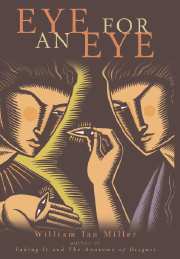Book contents
- Frontmatter
- Contents
- Preface: A Theory of Justice?
- 1 Introductory Themes: Images of Evenness
- 2 The Talion
- 3 The Talionic Mint: Funny Money
- 4 The Proper Price of Property in an Eye
- 5 Teaching a Lesson: Pain and Poetic Justice
- 6 A Pound of Flesh
- 7 Remember Me: Mnemonics, Debts (of Blood), and the Making of the Person
- 8 Dismemberment and Price Lists
- 9 Of Hands, Hospitality, Personal Space, and Holiness
- 10 Satisfaction Not Guaranteed
- 11 Comparing Values and the Ranking Game
- 12 Filthy Lucre and Holy Dollars
- Conclusion
- Notes
- Works Cited
- Index
5 - Teaching a Lesson: Pain and Poetic Justice
Published online by Cambridge University Press: 18 December 2009
- Frontmatter
- Contents
- Preface: A Theory of Justice?
- 1 Introductory Themes: Images of Evenness
- 2 The Talion
- 3 The Talionic Mint: Funny Money
- 4 The Proper Price of Property in an Eye
- 5 Teaching a Lesson: Pain and Poetic Justice
- 6 A Pound of Flesh
- 7 Remember Me: Mnemonics, Debts (of Blood), and the Making of the Person
- 8 Dismemberment and Price Lists
- 9 Of Hands, Hospitality, Personal Space, and Holiness
- 10 Satisfaction Not Guaranteed
- 11 Comparing Values and the Ranking Game
- 12 Filthy Lucre and Holy Dollars
- Conclusion
- Notes
- Works Cited
- Index
Summary
The formulation of the talion in Exodus adds stripe for stripe to the litany of lives, eyes, teeth, hands, burnings, and wounds that are to be compensated for in kind. Stripes are less about mutilations and disfigurement than about pain. Stripes are given to inflict pain, but they are an inadequate proxy for the pain actually felt. Although I can guess that you will value your hand as I value mine, I cannot in the least be sure you will feel the pains of a lashing to the same extent I do.
Pain thresholds, people have always known or suspected, vary greatly. Implicit in various forms of racism and classism is the view that the lower orders, whoever they may be, are impervious to pain, either from being accustomed to it or from being too insensible and stupid to feel it. And then, too, some people are better at taking it than others whatever their class, sex, or race. It was always a riddle I could never solve when the guys I played with and against when young could take hits that I could not imagine taking myself and thus shied away from, to the tune of their taunts. Was it that they had no nerve endings and hence were manifesting no virtue at all but simply felt no pain, or was it that they felt it but did not fear it or were not averse to it the way I was? Could it be they actually liked getting hit?
- Type
- Chapter
- Information
- Eye for an Eye , pp. 58 - 69Publisher: Cambridge University PressPrint publication year: 2005



